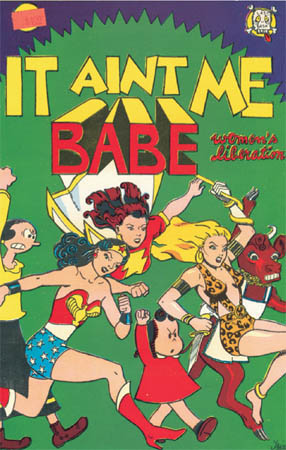
In response to the extreme violence and misogyny being portrayed by the male artists, female underground cartoonists banded together under the second-wave feminist ideology and started creating their own comic book backlash. At the forefront of this movement was cartoonist Trina Robbins. Robbins left her “male chauvinist pig” husband and joined the feminist West Coast newspaper It Aint Me Babe, drawing her Belinda Berkeley strip.
Finding it almost impossible to break into the “boys’ club” of underground comix, Robbins then created the accompanying anthology, It Aint Me Babe, published by Last Gasp in 1970. This was the first comic created solely by women, and featured Meredith Kurtzman and Lisa Lyons, among others. From 1970, the movement really got going, with the formation of the Wimmen’s Comix Collective. The original founders included Robbins, Aline Kominsky, Shelby Sampson, and Lora Fountain (Gilbert Shelton’s future wife). The Wimmen’s Comix Collective published 17 issues of its eponymous anthology, starting in 1972, and featured a wealth of female creators including Lynda Barry, Melinda Gebbie, and Janet Wolfe Stanley. Wimmen’s Comix continued to be published until 1992, making it the longest-running and most successful women’s underground comic.
Sex was an important component of these women’s comix, but it was a very different type of sex than that portrayed by their male counterparts. The stories were about female sexual empowerment, not relying on men, reactions to sexual harassment, birth control, and periods.
In many ways, Trina Robbins was the female antithesis of Robert Crumb. While he incited the men, Robbins spurred on the women with an almost fanatical zeal. In 1976, publisher Denis Kitchen finally saw the potential market for erotic comix aimed at women, and asked Robbins to create one for him. The result was Wet Satin (“Women’s Erotic Fantasies”), which featured Rawhide Revenge, Robbins’ parody of Eric Stanton’s classic bondage comics of the ’50s and ’60s.
The hypocrisy of the male-dominated society was brought into sharp relief when Kitchen Sink’s Mid-Western printer (who had already printed Bizarre Sex, with its cover images of giant vaginas landing on skyscrapers) refused to print Wet Satin because of the content. The first issue of Wet Satin was eventually printed in San Francisco and Robbins’ editorial in Issue 2 explained, “When asked why he [the printer] drew the line on Wet Satin #1, he answered that the predominately male comics were all satires, but that Wet Satin #1 was serious, and therefore pornographic.” Yet this wasn’t an unusual situation and women found the prejudices far greater against them producing erotic material than the men, to the point that some were threatened with legal action.
Cover to It Aint Me Babe #1 (1970) by Trina Robbins, paying tribute to various female characters including Olive Oyl, Wonder Woman, Mary Marvel, Little Lulu, and Sheena Queen of the Jungle.
The cover to Wimmen’s Comix #1 parodies the unrealistic romance comics of the time.
Cover to Wimmen’s Comix #9 by Lee Marrs.
Dianna Noomin’s cover for Wimmen’s Comix #11 in 1987, 15 years after the first issue.
Barb Rausch’s effete, naked cavalier, Roger Hawke, from the back cover of Wimmen’s Comix #16.
An Epidemic… cured by the pen, drawn by Joyce Farmer, mixes sex and sedition, encouraging people to call in “sick” to work, making a political statement about homosexuality being classed as an “illness” at the time in Sweden.
This fantasy strip by Trina Robbins has numerous visually coded sexual images, including the first panel with the unicorn.